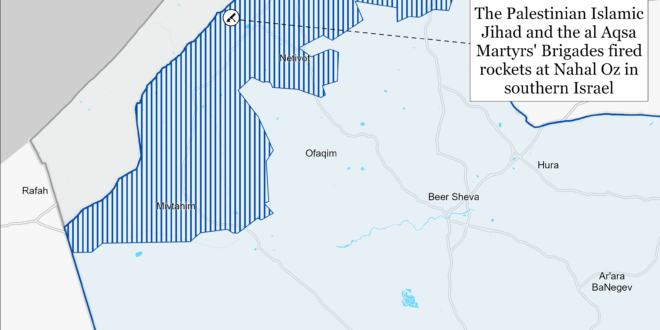Key Takeaways:
- Northern Gaza Strip: Palestinian militias claimed attacks in areas of the northern Gaza Strip where Israeli forces previously conducted clearing operations. The claimed attacks are consistent with CTP-ISW’s assessment that Hamas and other Palestinian militias are likely in the early stages of reconstituting their governance and military capabilities in the northern Gaza Strip.
- Central Gaza Strip: Hamas’ military wing conducted a complex attack that killed 21 Israeli soldiers in the deadliest single attack since Israeli ground operations began. The IDF Chief of Staff said that the fallen soldiers were conducting a defensive activity that will allow Israeli residents to return to their homes surrounding the Gaza Strip.
- Southern Gaza Strip: Israeli forces located an underground weapons production facility that the IDF said is the largest it has found to date. Palestinian militias are continuing to execute a deliberate defense against Israeli operations in western Khan Younis.
- Political Negotiations: Israel proposed a two-month pause in fighting in exchange for Hamas releasing over several phases the remaining hostages held in the Gaza Strip. An anonymous Egyptian official told the Associated Press that Hamas rejected the proposal.
- West Bank: Israeli forces clashed with Palestinian fighters twice in the West Bank. The IDF detained eight wanted individuals and confiscated weapons.
- Southern Lebanon and Golan Heights: Lebanese Hezbollah claimed three attacks from southern Lebanon into northern Israel. Israeli media reported that the IDF Air Force destroyed an unspecified military asset used by Hezbollah but operated by Iran.
- Iraq: The Shia Coordination Framework—a loose coalition of Iranian-backed Shia political factions—discussed Iranian-backed militia efforts to “provoke” US self-defense strikes in a meeting.
- Syria: Israel likely conducted two airstrikes targeting an IRGC weapons storage facility and an Iranian-backed militia truck transporting weapons around Albu Kamal, Syria.
- Yemen: US and UK forces conducted combined strikes on eight Houthi military targets in Yemen. The Houthis are harassing UN operations and personnel in Yemen.
- Iran: Iranian Supreme Leader Ali Khamenei criticized Islamic countries for not demanding a ceasefire for the Israel-Hamas war during a meeting with the Tehran branch of the Martyrs’ Commemoration National Congress.

Gaza Strip
Axis of Resistance campaign objectives:
Erode the will of the Israeli political establishment and public to launch and sustain a major ground operation into the Gaza Strip
Degrade IDF material and morale around the Gaza Strip.Palestinian militias claimed attacks on January 23 in areas of the northern Gaza Strip where Israeli forces previously conducted clearing operations. The claimed attacks are consistent with CTP-ISW’s assessment that Hamas and other Palestinian militias are likely in the early stages of reconstituting their governance and military capabilities in the northern Gaza Strip.[i] Hamas’ military wing used thermobaric rockets, sniper rifles, and mortars to target Israeli forces southwest of Gaza City.[ii] Hamas claimed that its fighters seized three drones south of Zaytoun and detonated a mine field targeting Israeli vehicles in Juhor ad Dik.[iii] Several Palestinian militias separately claimed attacks and published footage of their fighters targeting Israeli armor and dismounted infantry east of Jabalia.[iv] Israel Defense Forces (IDF) Chief of Staff Herzi Halevi said on January 23 that Israeli forces are continuing to fight in the northern Gaza Strip.[v]
Hamas’ military wing conducted a complex attack that killed 21 Israeli soldiers in the deadliest single attack since Israeli ground operations began. The IDF reported that Palestinian fighters fired rocket-propelled grenades (RPG) at Israeli forces near two buildings that the IDF had rigged to demolish and a nearby Israeli tank 600 meters west of Kissufim on January 22.[vi] The RPG detonated the IDF explosives on the two buildings, causing the buildings to collapse. The collapsing buildings and firefight killed 21 IDF soldiers.[vii] Hamas claimed responsibility for the attack on January 23.[viii] The group claimed that its fighters fired an “anti-personnel” rocket at Israeli engineers, causing a secondary detonation that collapsed the building. The fighters simultaneously fired an anti-tank RPG at an Israeli tank and detonated a mine field in the area. Israeli media and Hamas reported that the fighters responsible for the attack escaped.[ix]
The IDF Chief of Staff said during a visit to the site of the complex attack on January 23 that the fallen soldiers were conducting a defensive activity in the border area that will allow residents of the towns surrounding the Gaza Strip in Israel to return.[x]
Israeli forces located a large underground weapons production facility in the southern Gaza Strip.[xi] The IDF said that this facility is the largest facility it has found to date. The IDF 7th Brigade (assigned to the 36th Division) searched the 1.5-kilometer-long tunnel network during clearing operations in Khan Younis.[xii] Palestinian fighters opened fire from tunnel entrances and detonated improvised explosive devices at tunnel entrances to prevent Israeli forces from entering the complex. Israeli forces captured the weapons production facility and a large lathe for producing rockets. Israeli forces destroyed the underground tunnel system as part of their effort to degrade Hamas’ weapons and rocket production capabilities.[xiii]
Palestinian militias are continuing to execute a deliberate defense against the Israeli ground operation in western Khan Younis. The military wings of Palestinian Islamic Jihad (PIJ), Fatah, and the Popular Front for the Liberation of Palestine (PFLP) claimed most of their attacks targeting Israeli forces in the Gaza Strip on January 23 in western Khan Younis.[xiv] PIJ claimed that it targeted an Israeli tank with an explosively formed penetrator (EFP).[xv] Hamas fighters prevented an Israeli quick reaction force from removing an immobile tank after the fighters fired an RPG at it on January 21.[xvi]
The IDF reported on January 23 that its 98th Division encircled Khan Younis.[xvii] IDF Spokesperson Rear Admiral Daniel Hagari said that Israeli forces killed more than 100 operatives in western Khan Younis on January 23.[xviii] The 98th Division is executing an “expanded” clearing operation in western Khan Younis to “dismantle” Hamas’ military forces in Khan Younis.[xix]
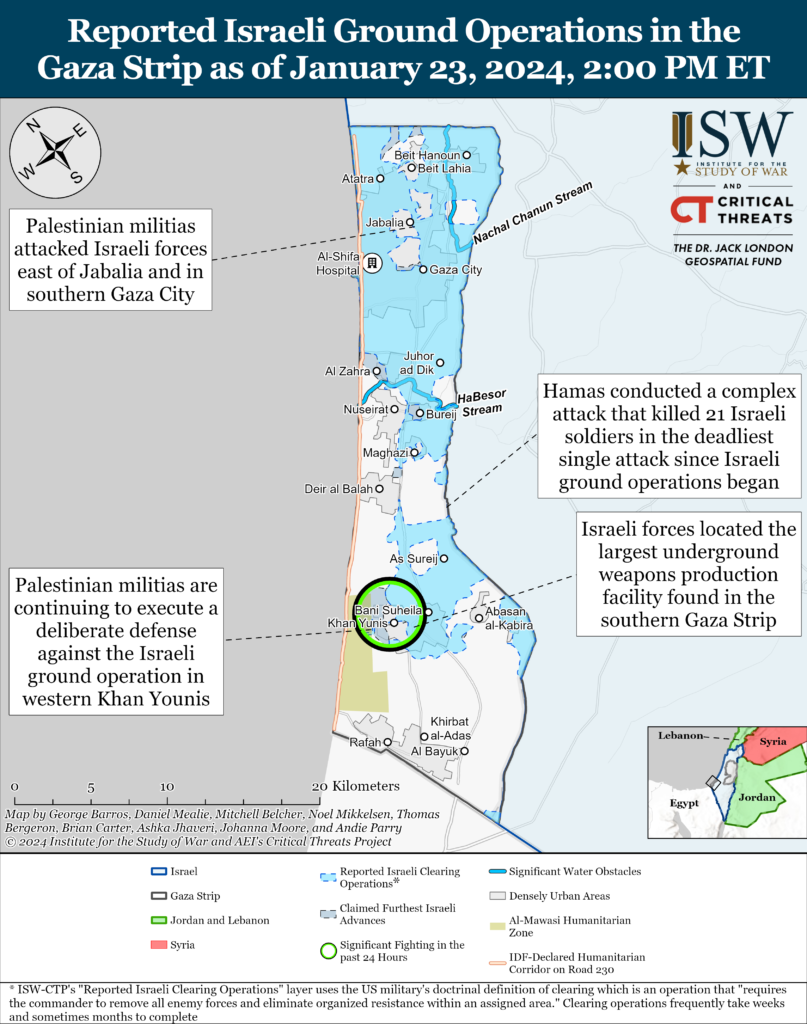
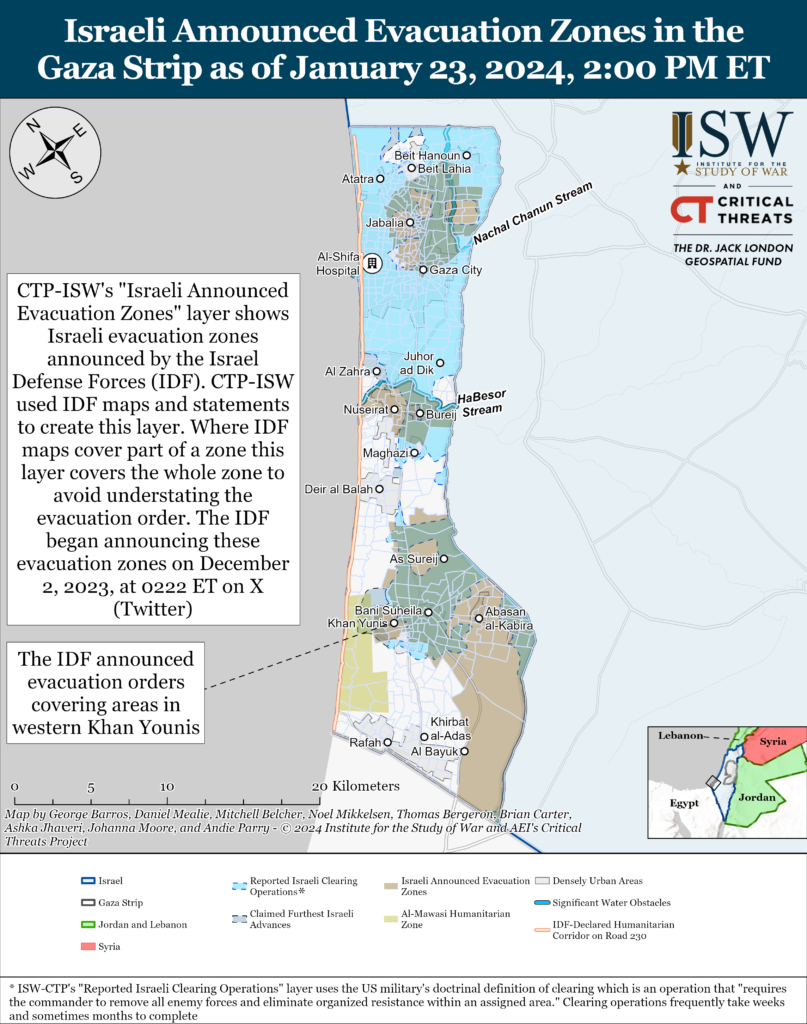
Israel proposed a two-month pause in fighting in exchange for Hamas releasing over several phases the remaining hostages held in the Gaza Strip.[xx] The first phase would have Hamas return women, men over 60 years old, and hostages in critical medical condition. Israeli media reported that the ”next phases” would include the release of female IDF soldiers, civilian males under the age of 60, Israeli male soldiers, and the bodies of hostages. An anonymous Israeli official told an Israeli journalist that the proposal includes redeploying the IDF out of main population centers in the Gaza Strip to allow Palestinian civilians to return to these areas. The official added that this proposal does not include the release of all 6,000 Palestinian prisoners from Israeli prisons. An anonymous Egyptian official told the Associated Press that Hamas rejected the proposal, likely because it included no measures to end the Israeli effort to destroy Hamas.[xxi] Egyptian Intelligence Minister Abbas Kamel accused the Israeli government of “not being serious” about the negotiations because the proposal did not include an agreement to end the war, according to the Wall Street Journal.[xxii]
The Israeli proposal is very similar to the US-Egyptian-Qatari plan that the Wall Street Journal reported on January 21.[xxiii] The Wall Street Journal reported that Hamas would release all remaining Israeli hostages under this plan in exchange for Israel releasing an unspecified number of Palestinian prisoners over a 90-day pause in fighting. This pause—according to the US-Egyptian-Qatari proposal—would lead to a permanent ceasefire in the Gaza Strip, the normalization of Israeli-Saudi relations, and the relaunching of the process to form a Palestinian state.
Unspecified Arab officials told the Wall Street Journal that four unspecified Arab states and Saudi Arabia proposed a separate plan for the Gaza Strip’s post-war governance.[xxiv] Egyptian and Saudi officials said that the primary obstacle is the creation of a Palestinian state—a step that Israel has continually rejected.[xxv] The five Arab countries said that they will train Palestinian security forces, “revive and reform” the Palestinian Authority, and eventually “help organization elections,” according to the Arab officials. Egyptian and Saudi officials said that they are still finalizing the plan.[xxvi]
The IDF Arabic-language spokesperson posted new evacuation orders covering specific areas in western Khan Younis on X (Twitter) at 03:52 EST on January 23.[xxvii] The orders highlight specific blocks and neighborhoods in al Nasr, al Amal, the city center, and the refugee camp. The spokesperson told residents to immediately move to the al Mawasi Humanitarian Zone.
The Gaza Strip is experiencing the tenth telecommunications blackout since the Israel-Hamas war began. NetBlocks reported on January 23 that the Gaza Strip entered the second day of the telecommunications blackout.[xxviii]
The al Quds Brigades and al Aqsa Martyrs’ Brigades launched mortars from the Gaza Strip in a combined operation targeting Nahal Oz in southern Israel on January 23.[xxix] The al Quds Brigades is the militant wing of PIJ. The al Aqsa Martyrs’ Brigades is the self-proclaimed militant wing of Fatah.
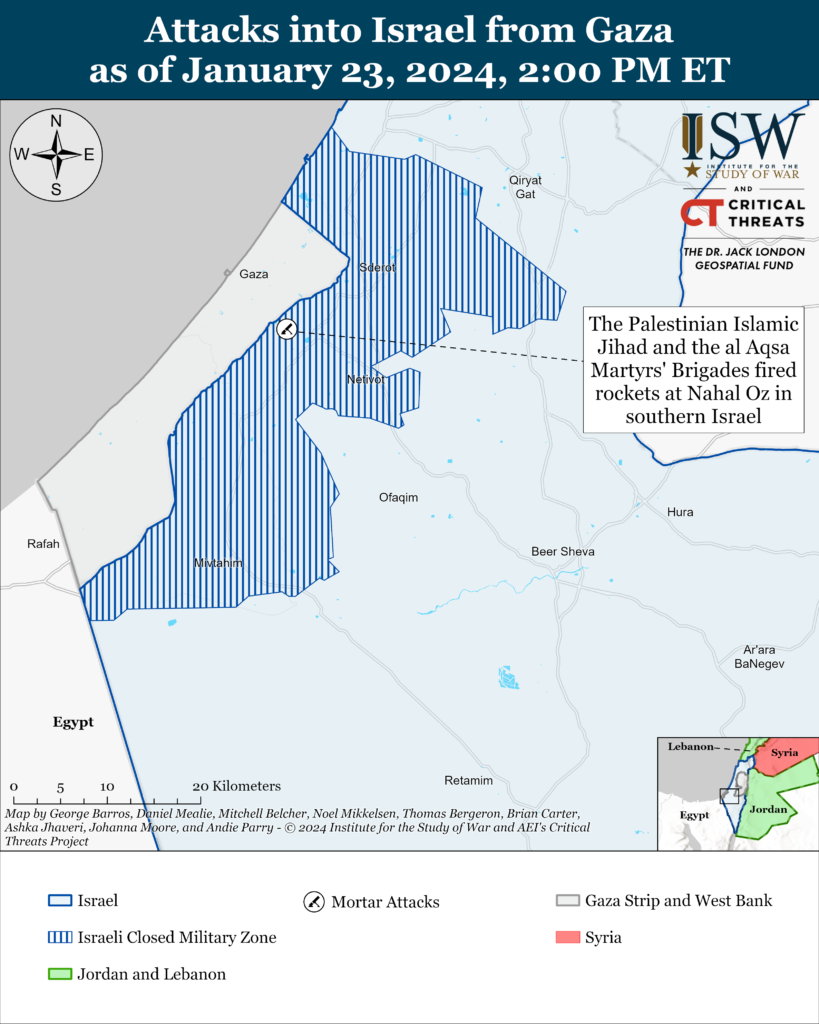
Recorded reports of attacks; CTP-ISW cannot independently verify impact.
West Bank
Axis of Resistance campaign objectives:
Draw IDF assets and resources toward the West Bank and fix them thereIsraeli forces clashed with Palestinian fighters two times in the West Bank on January 23.[xxx] The IDF detained eight wanted individuals and confiscated weapons during operations in the West Bank.[xxxi] The IDF said that Israeli forces shot an individual armed with a knife as the individual approached an Israeli post near Ramallah.[xxxii]
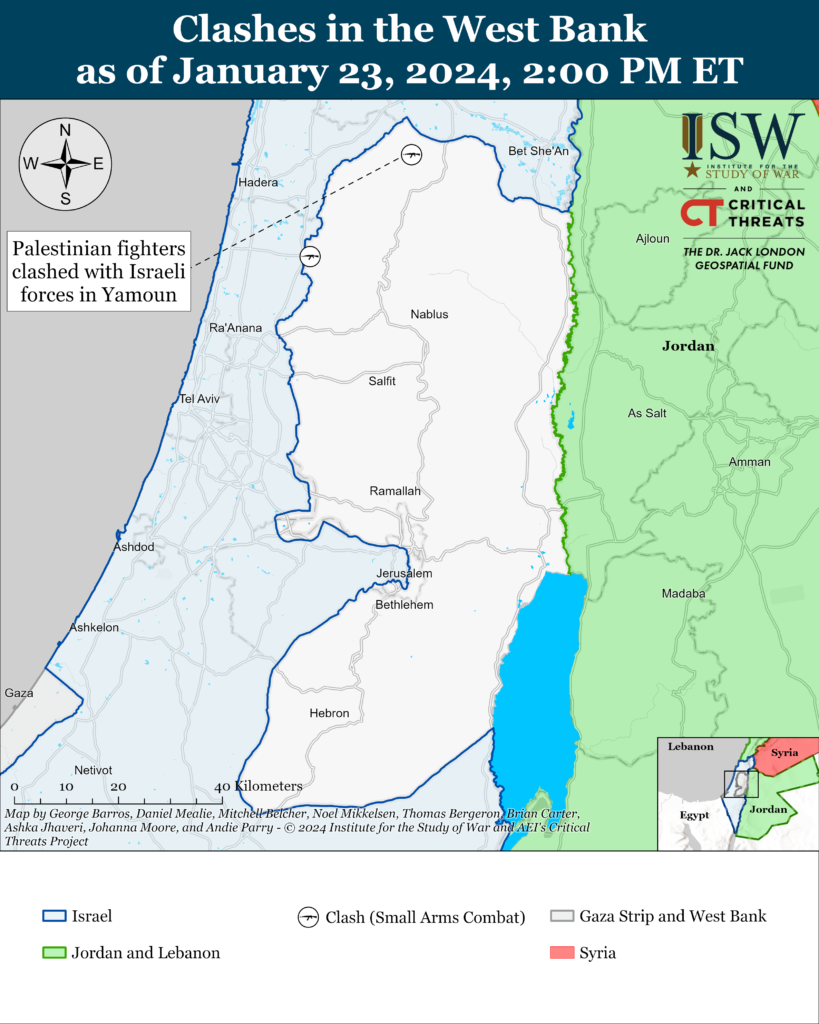
Bank.
Southern Lebanon and Golan Heights
Axis of Resistance campaign objectives:
Draw IDF assets and resources toward northern Israel and fix them there
Set conditions for successive campaigns into northern IsraelLebanese Hezbollah claimed three attacks from southern Lebanon into northern Israel on January 23.[xxxiii] Hezbollah launched at least 15 rockets targeting an IDF base on Mount Meron that hosts air traffic control, radar, surveillance, communication, and jamming facilities.[xxxiv] The IDF stated that the attack caused minor damage to the base but that it did not impact the base’s reconnaissance capabilities.[xxxv] Hezbollah stated that it targeted Mount Meron ”in retaliation“ for recent unspecified assassinations in Lebanon and Syria.[xxxvi] Israel has targeted Iranian and Hezbollah military commanders responsible for facilitating the movement of Iranian-provided materiel that Hezbollah uses to target northern Israel. Hezbollah targeted Mount Meron for the first time on January 6 after Israel killed Hamas Political Bureau Deputy Chairman Saleh al Arouri in Beirut on January 2.[xxxvii]
Israeli media reported that the IDF Air Force destroyed an unspecified military asset used by Hezbollah but operated by Iran.[xxxviii] Israeli media has provided no further details on the incident at the time of writing.
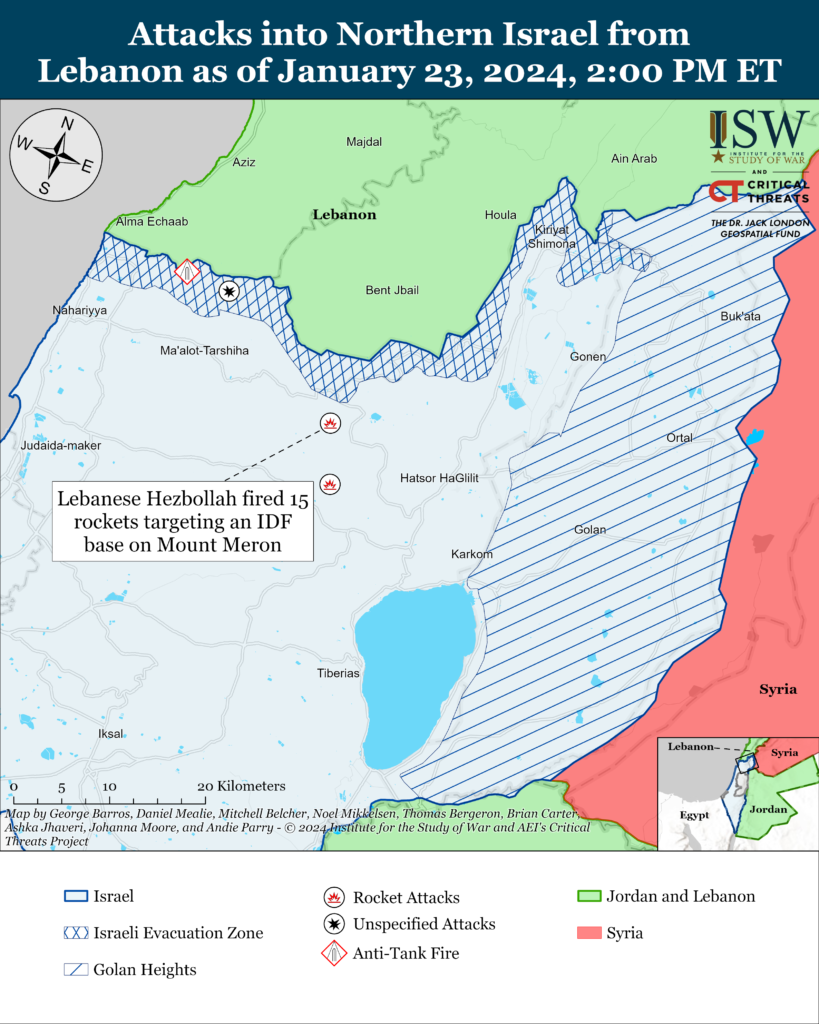
Recorded reports of attacks; CTP-ISW cannot independently verify impact.
Iran and Axis of Resistance
Axis of Resistance campaign objectives:
Demonstrate the capability and willingness of Iran and the Axis of Resistance to escalate against the United States and Israel on multiple fronts
Set conditions to fight a regional war on multiple frontsThe Islamic Resistance in Iraq—a coalition of Iran-backed Iraqi militias—claimed responsibility for two one-way drone attacks and a rocket attack targeting US positions in Iraq and Syria. The group claimed two one-way drone attacks targeting US forces at Ain al Assad airbase in western Iraq on January 23.[xxxix] The Islamic Resistance in Iraq also fired a rocket salvo targeting US forces at the Conoco Mission Support Site in Deir ez Zor Province on January 22, after CTP-ISW’s data cutoff that day.[xl] CTP-ISW reported on January 22 that the group fired two previous barrages of rockets targeting US forces at the Conoco Mission Support Site earlier on January 22.[xli]
The Islamic Resistance in Iraq also launched one unspecified drone targeting the Israeli port of Ashdod, south of Tel Aviv.[xlii] This is the first Islamic Resistance in Iraq attack targeting Ashdod during the war.


The Shia Coordination Framework—a loose coalition of Iranian-backed Shia political factions—discussed Iranian-backed militia efforts to “provoke” US self-defense strikes in a meeting on January 22.[xliii] Coordination Framework leadership discussed “solutions” to the Iranian-backed militia ”provocation” of US forces. An MP from the Iranian-backed Badr Organization’s Fatah Alliance said that these solutions include the removal of US forces from Iraq. Many parties within the Shia Coordination Framework, including the Fatah Alliance, are political wings of Iranian-backed militias that have been waging a campaign combining political and military pressure to remove US forces from Iraq.[xliv] Iranian-backed Iraqi groups and politicians frequently frame US self-defense strikes as crimes and violations of Iraqi sovereignty to pressure the Iraqi government to order the withdrawal of US forces from Iraq.[xlv]
Israel likely conducted two airstrikes targeting an IRGC weapons storage facility and an Iranian-backed militia truck transporting weapons around Albu Kamal, Syria, on January 23.[xlvi] Israeli media reported that the strike on the truck killed at least two Iranian-backed militia members.[xlvii] Syrian media reported that the militia members belonged to the Iraqi Popular Mobilization Forces.[xlviii] Israel has conducted a series of airstrikes since early December 2023 targeting IRGC Quds Force weapons shipments and personnel responsible for supplying Lebanese Hezbollah through Syria.[xlix] Israeli media said on December 29 that Israel’s strikes are responding to Iranian efforts to accelerate the supply of military equipment to Lebanese Hezbollah, which is using the Iranian-provided equipment to support attacks into northern Israel.[l]
US and UK forces conducted combined strikes on eight Houthi military targets in Yemen on January 22.[li] Australia, Bahrain, Canada, and the Netherlands supported the operation, which targeted Houthi missile systems and launchers, air defense systems, radars, and deeply buried weapons storage facilities. The UK Defense Ministry stated that four of its aircraft struck targets near ”Sanaa airfield.”[lii] Sanaa airfield probably refers to Dailami airbase, which is north of Sanaa. The Houthi military spokesperson claimed that US and UK forces struck targets in four governorates.[liii] The spokesperson also stated the Houthis will respond to the strikes. US CENTCOM stated that the strikes aimed to degrade the Houthi capability to conduct attacks on international commercial shipping and US and UK ships. CENTCOM added that the strikes “are separate and distinct” from Operation Prosperity Guardian, which is a multinational coalition protecting freedom of navigation in the Red Sea, Bab al Mandeb and the Gulf of Aden.
The Houthis are harassing UN operations and personnel in Yemen. The Houthi Foreign Affairs Ministry ordered on January 20 the UN resident coordinator in Sanaa to expel all UN humanitarian workers with US or UK citizenships by February 18.[liv] The Houthi ministry also ordered the United Nations to stop recruiting US and UK citizens as employees within Yemen. The internationally recognized Yemeni government’s information minister separately claimed that Houthi air traffic control threatened to shoot down a UN plane that was en route to Marib Governorate on January 23.[lv]
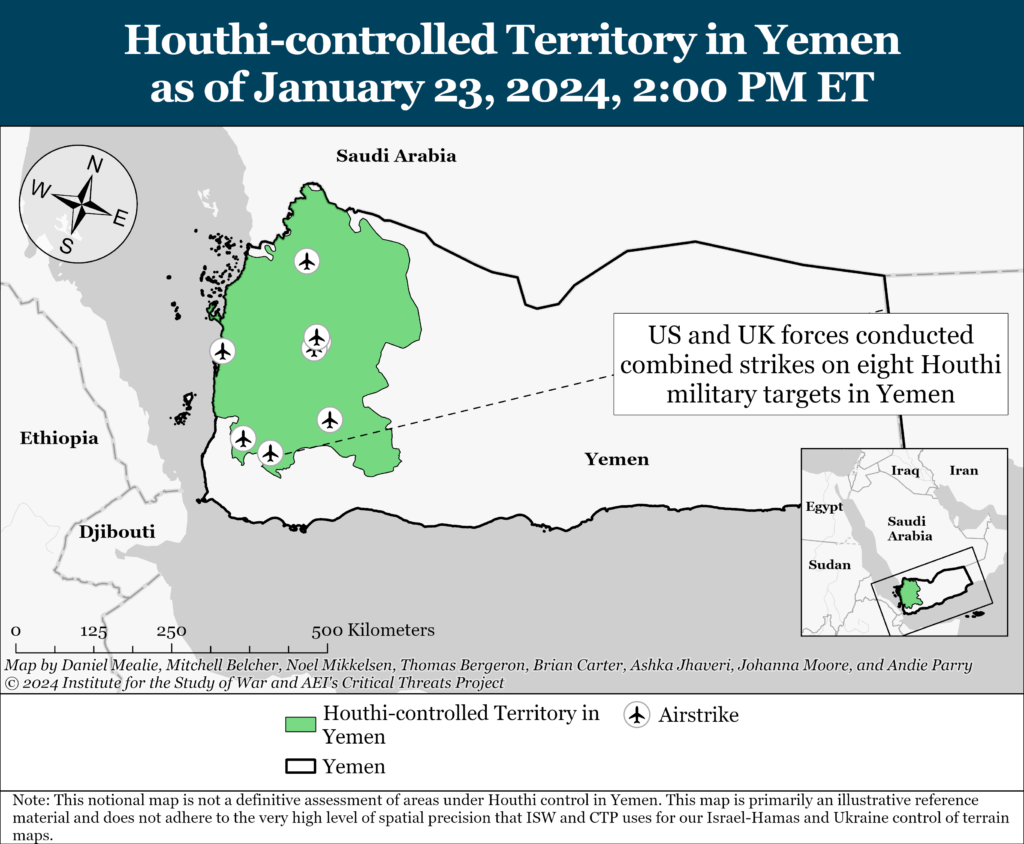
Iranian Supreme Leader Ali Khamenei criticized Islamic countries for not demanding a ceasefire for the Israel-Hamas war during a meeting with the Tehran branch of the Martyrs’ Commemoration National Congress on January 23.[lvi] Khamenei urged Islamic countries to take actions, such as severing their respective political and economic relations with Israel.
Iranian Foreign Affairs Minister Hossein Amir Abdollahian discussed recent Israeli airstrikes targeting IRGC assets in Syria with UN Special Representative for Syria Geir Pederson in New York on January 23.[lvii] Abdollahian called on the international community to halt the Israeli strikes in Syria.
Iranian Foreign Affairs Minister Hossein Amir Abdollahian discussed the Israel-Hamas war with his Russian counterpart, Sergei Lavrov, at a meeting in New York on January 23.[lviii] Abdollahian demanded that Russia use its role as a permanent member of the UN Security Council to more actively secure a ceasefire to the war. Lavrov criticized the United States for obstructing the previous ceasefire resolution in the UN Security Council on January 9.[lix] Abdollahian said that he hopes that Russian President Vladimir Putin would sign a bilateral comprehensive strategic cooperation agreement with Iran during Putin’s upcoming visit to Tehran.
Abdollahian discussed the Israel-Hamas war in a meeting with Lebanese Foreign Affairs Minister Abdallah Bou Habib in New York on January 23.[lx] Abdollahian condemned Israeli actions in the Gaza Strip.
 Eurasia Press & News
Eurasia Press & News
